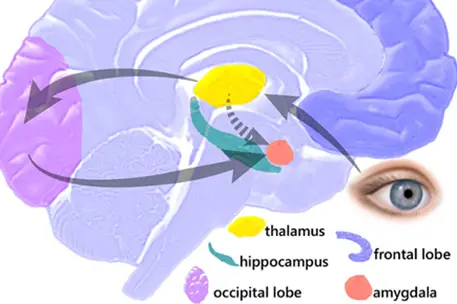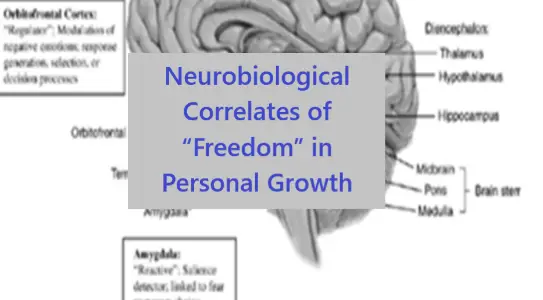Neurobiological Correlates of “Freedom”
Freedom is the ability to respond rather than react. This means that in the mind, you notice your body has detected a stressor. And in the brain, you are conscious of your amygdala’s message that a threat is detected.
Viktor Frankl says: “Between stimulus and response, there is a space. In that space is our power to choose our response. In our response lies our growth and our freedom.” ( Often attributed to Steven Covey or Viktor E. Frankl )
What is this “space” that Frankl says is necessary for growth and freedom? That space that provides the power to choose to respond or react to a stimulus?
Neurobiologically speaking, it is the pathway that connects the amygdala to the cortex. Those nerve fibers are freedom.
How You Detect a Stimulus
We are interested in the freedom that comes from nonreactivity to offensive stimuli. An example would be not getting triggered by something that used to set you off into full sympathetic and cortisol storms.
All the fuss starts when your brain (amygdala) detects a stimulus that causes a response before cortical brain involvement (and the opportunity to down-regulate the reaction).
A unique way of thinking about how you notice stress in the environment around you is provided by the Polyvagal Theory. The theory’s creator, Steven Porges, coined “neuroception.”
Neuroception is how your amygdala detects a stressful signal from the environment. This allows your autonomic nervous system to kick in before you are conscious of a threat.
Neuroception is entirely subconscious. It is why you startle before a car wreck or when a bird divebombs you. Your senses detect a threat and send the message to your amygdala before your cortex gets the message. This is how you detect stress unconsciously. Freedom is the process of bringing this response into consciousness.

Clinical Correlate of Freedom: The Amygdala Hijack
An Amygdala hijack is a clinical correlate of anti-freedom. When hijacked, the amygdala stimulates the flight or fight sympathetic response before conscious activation of the cortex. Thus, before you can stop it, you are “triggered.”
This emotional brain activity processes information milliseconds earlier than the rational brain, so in case of a match, the amygdala acts before any possible direction from the neocortex can be received. If, however, the amygdala does not find any match to the stimulus received with its recorded threatening situations, then it acts according to the directions received from the neocortex. When the amygdala perceives a threat, it can lead that person to react irrationally and destructively. (source)
Neurobiology of Freedom
To be nonreactive, we develop the circuits in our brain that allow our higher cortical circuits to control the lower affect-generating ones better. That is, have a balance of emotional arousal and regulation.
Emotional Intelligence visualized this as the “relationship between the subcortical limbic amygdala and the prefrontal cortex.” This is called the orbital-medial prefrontal cortex: amygdala network.
There are direct connections between the prefrontal cortex and the lower limbic area. “These linkages enable the prefrontal area to both assess the state of arousal in these subcortical regions as well as to modulate their firing.” This connection is mindful awareness of your arousal system. (source: The Mindful Brain)
Thus, you can have balance and coordination via your frontal cortex. You can have excitement, purpose and meaning, and emotional richness and balance out the chaotic stimuli, dullness, and depressing rigidity.
In addition, you regulate the sympathetic and parasympathetic branches of the autonomic nervous system. This is how the middle part of the prefrontal cortex shuts down your fight or flight response. Those fibers are nonreactivity; how your brain controls the stress response.
In these two ways we can see that “nonreactivity” is likely to involve both internal affective and autonomic balance and interactive flexibility. These, and other dimensions of our internal homeostasis, are achieved through the integrative (coordinating, balancing) functions of the prefrontal cortex. It is these regions that we can propose are likely active during mindful practice and grow and strengthen their connections as a consequence.
A Word on Resilience
Nonreactivity also includes resilience. Resilience is how long a negative affect persists after adversity.
Resilience can be learned through experience. Affective style is not fixed in cement by genes or by early experience but can be seen as a skill that, with training, can be moved in the direction of well-being… I’m suggesting that we view mindfulness as a form of “attention and care” focused on oneself. This is how we can see mindfulness as a form of intrapersonal attunement that also promotes resilience.
A Left Shift
To me, a left shift means immature neutrophils. But another use is the idea that your left hemisphere is approach and right is withdrawal. Thus, a left shift is an ability to approach even negative events rather than withdrawal. Mindfulness can be seen as a left shift of the cerebral hemispheres.
Summary—Neurobiological Correlates of Freedom
In summary, through mindfulness and meditation, you strengthen the space in your brain that allows you to regulate stimuli better. Your amygdala’s trigger point is set lower, and there are more inhibitory pathways from the cortex. Next, the pathways from your cortex to your amygdala become more active and inhibitory. This allows decisions in the cortex before catecholamines and cortisol’s dramatic effect on cortex function. This is freedom. You respond rather than react. That space is neuroplasticity’s effect of mindfulness.
“The one thing you can’t take away from me is the way I choose to respond to what you do to me. The last of one’s freedoms is to choose one’s attitude in any given circumstance.”
― Viktor E. Frankl
Freedom also allows you to choose your attitude, even under stressful circumstances. After all, the only control we have in this life is control of how we respond to things.
The moment of freedom is when your amygdala decides to act, and you notice it and control your response.

